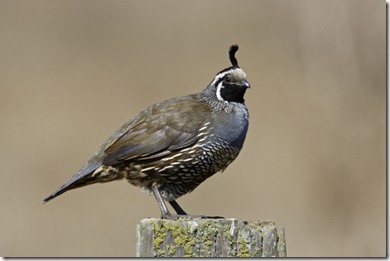Animal of the Day
The California Quail is a handsome, round soccer ball of a bird with a rich gray breast, intricately scaled under parts, and a curious, forward-drooping head plume. Its stiffly accented Chi-ca-go call is a common sound of the chaparral and other brushy areas of California and the Northwest. Often seen scratching at the ground in large groups or dashing forward on blurred legs, California Quail are common but unobtrusive. They flush to cover if scared, so approach them gently.
Cool Facts
The California Quail digests vegetation with the help of protozoans in its intestine. Chicks acquire the protozoans by pecking at the feces of adults.
Several California Quail broods may mix after hatching, and all the parents care for the young. Adults that raise young this way tend to live longer than adults that do not.
Pairs of California Quail call antiphonally, meaning that the male and female alternate calls, fit them into a tightly orchestrated pattern.
The California Quail’s head plume, or topknot, looks like a single feather, but it is actually a cluster of six overlapping feathers.
As an adaptation to living in arid environments, California Quails can often get by without water, acquiring their moisture from insects and succulent vegetation. During periods of sustained heat they must find drinking water to survive.
The California Quail is California’s state bird and has had roles in several Walt Disney movies, including “Bambi.”
California Quail nests can contain as many as 28 eggs. These large clutches may be the result of females laying eggs in nests other than their own, a behavior known as “egg-dumping.”
California Quail are pretty as well as popular with game hunters. They’ve been introduced to many other parts of the world, including Hawaii, Europe, and New Zealand.
The oldest known California Quail was 6 years 11 months old.
Habitat
California Quail are characteristic birds of coastal sagebrush, chaparral, foothills, and high desert of California and the northwestern United States. They’re also frequent visitors to backyards, especially if there’s birdseed available at ground level.
Food
Mainly a seedeater; also eats leaves, flowers, catkins, grain, Manzanita and poison oak berries, acorns, and invertebrates such as caterpillars, beetles, mites, millipedes, and snails. Diet is typically about 70 percent vegetarian.
Nesting
Nesting Facts
Clutch Size
· 12–16 eggs
Number of Broods
· 1-2 broods
Egg Length
· 1.3 in
Egg Width
· 1 in
Incubation Period
· 22–23 days
Egg Description
· White to creamy with variable brown markings.
Condition at Hatching
· Covered in brownish down. Can walk, follow parents, and peck at the ground immediately after hatching.
Nest Description
The nest is usually a shallow depression lined with stems and grasses, and often placed near vegetation or rocks for protection. Nest range from 5-7 inches across and 1-2 inches deep.
Nest Placement
Ground
Female California Quail typically hide their nests on the ground amid grasses or at the bases of shrubs or trees. Occasionally places nest up to 10 feet off the ground.
Behavior
Ground Forager
You’ll normally see California Quail walking, running, or scratching at the ground and leaf litter for seeds and other food. They occasionally forage in trees. California Quail generally forage in open areas but stay close to cover. When running, they can move amazingly quickly despite their short legs. If pressed by a predator they will burst into flight with rapid, whirring wingbeats. California Quail form flocks known as coveys in fall and winter; these usually contain family groups and can number more than 75 individuals. They roost in trees and feed mainly in the morning and evening, spending most of the day in shrubs that shade them from the sun and protect them from predators.
status via IUCN
Least Concern
Not threatened or endangered in any part of its range. California Quail are popular game birds, and between 800,000 and 1.2 million are shot each year in California alone. This level of hunting pressure does not seem to be hurting California Quail populations.
Source: http://www.allaboutbirds.org/guide/california_quail/lifehistory

 (916) 434-2759
(916) 434-2759



